Wearable Payment Devices Market Research, 2031
The global Wearable Payment Devices Market was valued at $47.1 billion in 2021 and is projected to reach $158.8 billion by 2031, growing at a CAGR of 13.3% from 2022 to 2031.
The ongoing technological advancements and surge in demand have an impact on market growth. Furthermore, the report provides a quantitative and qualitative analysis of the wearable payment devices market, as well as a breakdown of the pain points, value chain analysis, and key regulations.
The wearable payments enable users to buy products and services securely by utilizing innovative technologies built into their wearable gadgets. It is known as the tap-and-go payment method by many businesses and organizations since it gives retailers and suppliers a more secure and error-free payment option.
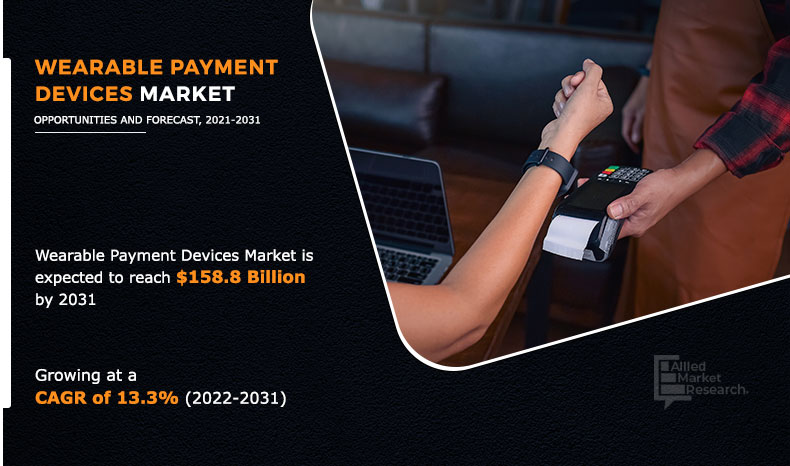
In addition, it enables tapping of contactless cards or payment-enabled devices for executive payments. Moreover, contactless payments are used in BFSI, retail, energy & utilities, and several other sectors due to benefits offered by this technology, including reduced transaction time, increased convenience, and leveraging customers' experience at POS terminals during transactions. Rise in smartphone penetration, increase in convenience & reduced transaction time provided by wearable payment technology, and surge in demand for mobile & wearable contactless payment devices boost the market growth. However, difficulties in the process of replacement of POS terminals, lack of consumer awareness, and security issues associated with technology hamper the market growth. Moreover, integration of IoT and contactless payments technology, and an increase in adoption in emerging economies are expected to boost the market growth in the coming years.
On the contrary, rise in demand for mobile and wearable payment devices is expected to offer remunerative opportunities for the expansion of the market during the forecast period.
Key Takeaways
- The global market study covers 20 countries. The research includes a segment analysis of each country in terms of value for the projected period.
- More than 1,500 product literatures, industry releases, annual reports, and other such documents of major market industry participants along with authentic industry journals, trade associations' releases, and government websites have been reviewed for generating high-value industry insights.
- The study integrated high-quality data, professional opinions and analysis, and critical independent perspectives. The research approach is intended to provide a balanced view of global markets and to assist stakeholders in making educated decisions to achieve their most ambitious growth objectives.
Segment Overview
The wearable payment devices market analysis is based on device type, technology, application, and region.
By device type, the market is classified into fitness trackers, smart watches, payment wristbands, and smart rings. The increasing shift from traditional payment systems to digital systems across developing nations and the increasing trend of mobile commerce across the globe boost the growth of the global wearable payment devices market.
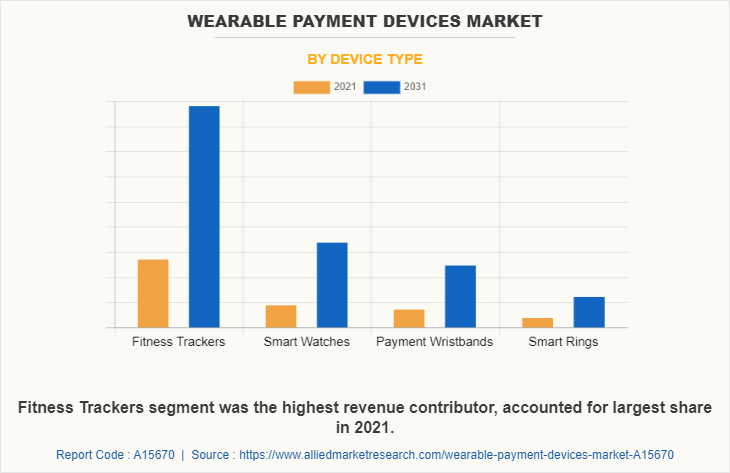
By application, it is fragmented into retail & grocery stores, entertainment centers, restaurants & bars, and hospitals & pharmacies. In addition, the surge in penetration of contactless payment systems at various retail stores, petrol pump stations, and restaurants positively impacts the growth of the market.
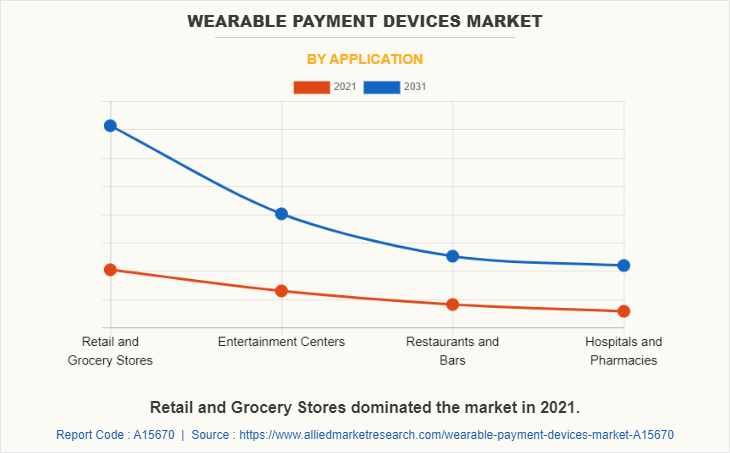
By technology, it is divided into near-field communication technology (NFC), radio frequency identification (RFID), and QR and Barcode. Furthermore, wearable payment devices deliver numerous benefits to customers, which include convenient payment processing with the use of a wallet or credit card, real-time updates on rewards points, and increased security to users’ financial details.
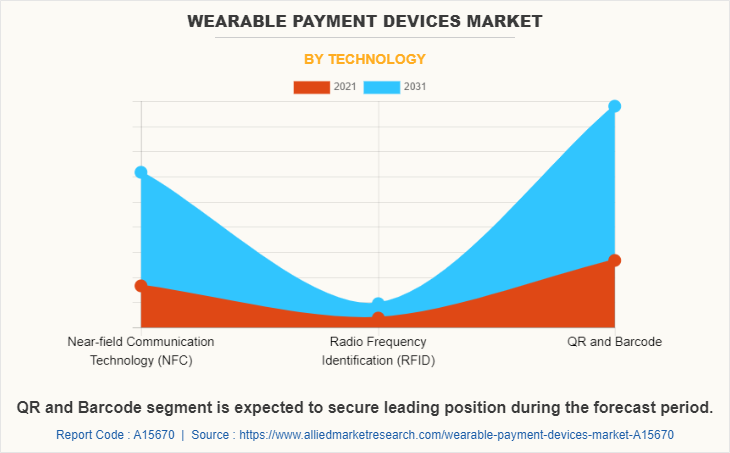
Regional/Country Market Outlook
North America: North America dominates the wearable payment devices market, with high adoption rates of wearable technology and a well-established digital payment infrastructure. The U.S. leads the market due to the increasing number of consumers opting for contactless payment methods.
Europe: Europe is another key region for wearable payment devices, with countries like the U.K., Germany, and France at the forefront of adopting innovative payment solutions. The growing popularity of fitness wearables integrated with payment functionalities is driving the market.
Asia-Pacific: Asia-Pacific is anticipated to witness significant growth due to the rising adoption of mobile payments and wearable technologies in countries like China, India, Japan, and South Korea. The region’s expanding middle class and increasing internet penetration are key growth drivers.
Latin America and Middle East & Africa: The adoption of wearable payment devices in these regions is growing, albeit at a slower pace compared to North America and Europe. However, the growing mobile payment ecosystem is expected to drive demand for wearable payment solutions in the coming years.
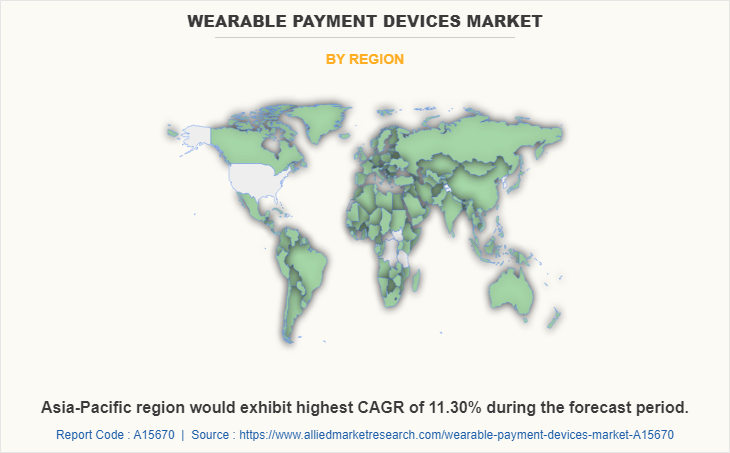
Top Impacting Factors
Significant factors impacting the growth of the wearable payment devices market include an increase in the trend of NFC-based mobile commerce across the globe and an increase in the shift from traditional payment systems to digital systems across developing nations. However, the difficulties in the replacement process of point-of-sale (POS) terminals may hamper market growth. Furthermore, the increase in the use of advanced technology, such as 5G and blockchain technology, in payment systems worldwide provides a lucrative wearable payment device market opportunity.
Competitive Analysis
The global Wearable Payment Devices Market Outlook is highly competitive, owing to the strong presence of existing vendors. Vendors of the wearable payment devices market with extensive technical and financial resources are expected to gain a competitive advantage over their competitors because they can cater to market demands. The competitive environment in this market is expected to increase as product launches and different strategies adopted by key vendors increase. Competitive analysis and profiles of the major global wearable payment devices market players that have been provided in the report include Apple Inc., Samsung Electronics Co Ltd, Garmin Ltd., Xiaomi Corporation, Google LLC, Visa, Inc., Barclays, PayPal Holdings, Inc., Mastercard Inc., Fitbit (Google), and Tappy Technology Ltd.
Key Market Dynamics
The wearable payment devices market is gaining momentum due to the growing adoption of contactless payment technologies and the increasing popularity of wearable devices such as smartwatches, fitness trackers, and smart rings. The market is driven by factors like the rise in digital payments, enhanced security features of wearable payment devices, and the convenience they offer to consumers. The COVID-19 pandemic further accelerated the demand for contactless payment solutions, contributing to market growth. However, data privacy concerns and high costs of wearable payment devices may pose challenges for market expansion.
Report Coverage & Deliverables
This report offers a detailed analysis of the wearable payment devices market, covering key segments such as device type, application, technology, and region. The report provides insights into market trends, competitive landscape, and potential growth opportunities, along with detailed forecasts for each segment. Deliverables include market size estimations, strategic developments, and key technological innovations impacting the market.
Device Type Insights
The wearable payment devices market is categorized into Fitness Trackers, Smartwatches, Payment Wristbands, and Smart Rings. Smartwatches hold a significant share due to their multi-functional capabilities, offering fitness tracking, communication, and secure payment solutions. These devices are increasingly popular due to their seamless integration with mobile payment systems. Fitness trackers, traditionally focused on health metrics, are now integrating payment functions to expand their use cases. Payment wristbands are particularly gaining traction for their convenience and affordability, especially in sectors like retail and entertainment. Smart rings, a newer category, are also emerging as discreet, compact devices that offer contactless payments, ideal for users seeking minimalistic wearables.
Application Insights
The market's applications include Retail and Grocery Stores, Entertainment Centers, Restaurants and Bars, and Hospitals and Pharmacies. Retail leads the adoption of wearable payment devices, where NFC-enabled wearables streamline the checkout process. Entertainment centers and restaurants leverage these devices to provide fast, contactless transactions for convenience and safety. Hospitals and pharmacies have started using wearable payment devices to enhance patient convenience, allowing them to make payments for prescriptions or services without the need for cash or cards. The increasing emphasis on frictionless customer experiences is driving the adoption of wearable payment devices across these sectors.
Technology Insights
The technology driving wearable payments includes Near-field Communication (NFC), Radio Frequency Identification (RFID), and QR and Barcode technologies. NFC is the dominant technology, offering seamless and secure communication between devices and payment terminals. It is widely used in smartwatches, fitness trackers, and wristbands due to its fast and secure transactions. RFID technology is employed mainly in wearable payment wristbands for events, entertainment centers, and other large-scale applications, where tracking and payment capabilities are combined. QR and Barcode technologies are becoming more common in budget-friendly wearables, allowing for digital payments without the need for physical cards or cash, especially in regions where NFC infrastructure is less developed.
Regional Insights
The report provides region-specific insights into the wearable payment devices market, examining the market dynamics in North America, Europe, Asia-Pacific, Latin America, and the Middle East & Africa. Regional analysis includes market drivers, opportunities, and challenges, along with forecasts based on current adoption rates and future trends.
Key Developments/ Strategies
According to the latest wearable payment devices market forecast, Samsung Electronics Co Ltd, Garmin Ltd., Xiaomi Corporation, Apple Inc., and Fitbit (Google) are the top 5 key players in the wearable payment devices market. Top market players have adopted various strategies, such as product launches to expand their foothold in the wearable payment devices market.
- In August 2022, Samsung Electronics Co. Ltd. announced the Galaxy Watch4 and Galaxy Watch4 Classic. They are the first smartwatches to feature the new Wear OS Powered by Samsung, built jointly with Google, and are equipped with One UI Watch, Samsung's most intuitive user interface yet. The Galaxy Watch4 Series is bolstered with advanced hardware performance and delivers a more seamless and connected user experience than ever before.
- In May 2022, Garmin International, Inc., a unit of Garmin Ltd. announced a band design for the popular vívofit jr. 3 kids' fitness trackers 1 lineup. Kids can track their daily activity with The Mandalorian band or a playful Grogu band.
- In December 2021, Xiaomi launched the wearable S1. The smartwatch is called Xiaomi Watch S1. Xiaomi has expanded the range following the release of Mi Watch Color, Watch Revolve, Mi Watch Revolve Active, and others. 91mobiles speculates that the wearable could be priced relatively affordable, as is the case with Xiaomi in smartphones and other products.
Key Benefits for Stakeholders
- This study comprises an analytical depiction of the wearable payment devices market size along with the current trends and future estimations to depict the imminent investment pockets.
- The overall wearable payment devices market analysis is determined to understand the profitable trends to gain a stronger foothold.
- The report presents information related to key drivers, restraints, and opportunities with a detailed impact analysis.
- The wearable payment devices market forecast is quantitatively analyzed from 2022 to 2031 to benchmark the financial competency.
- Porter’s five forces analysis illustrates the potency of the buyers and suppliers in the wearable payment devices market.
- The report includes the share of key vendors and market trends.
Wearable Payment Devices Market Report Highlights
| Aspects | Details |
| Market Size By 2031 | USD 158.8 billion |
| Growth Rate | CAGR of 13.3% |
| Forecast period | 2021 - 2031 |
| Report Pages | 397 |
| By Device Type |
|
| By Application |
|
| By Technology |
|
| By Region |
|
| Key Market Players | Barclays, Apple Inc., Tappy Technology Ltd, Fitbit (Google), Visa, Inc, Garmin Ltd., Mastercard Inc., Xiaomi Corporation, Samsung Electronics Co Ltd, Google LLC, PayPal Holdings, Inc |
Analyst Review
The wearable payment devices market is expected to leverage high potential for fitness trackers and smart watches during the forecast period.? Wearable payment devices vendors, investing substantially in R&D and skilled workforce, are anticipated to gain a competitive edge over their rivals. The competitive environment in the market is expected to further intensify with an increase in technological innovations, product extensions, and different strategies adopted by key vendors.?
Rise in adoption of wearable payments among people for fast and secure payment transactions. In addition, increase in adoption of advanced digital payment technology, such as growth in adoption of mobile point-of-sale (POS) machine, in retail industries in developing nations, such as China, India, and Japan, is expected to provide lucrative opportunities for the market growth.??
Key wearable payment devices market leaders profiled in the report include Apple Inc., Samsung Electronics Co Ltd, Garmin Ltd., Xiaomi Corporation, Google LLC, Visa, Inc., Barclays, PayPal Holdings, Inc., Mastercard Inc., Fitbit (Google), and Tappy Technology Ltd.?
The retail and grocery stores segment are the leading application of wearable payment devices market.
The upcoming trends of wearable payment devices market are increase in trend of NFC-based mobile commerce across the globe and increase in shift from traditional payment system to digital system across the developing nations.
Asia-Pacific is the largest regional market for wearable payment devices.
The global wearable payment devices market was valued at $47,091.2 million in 2021.
Huimu Ltd, Belden Inc, Startech.com and ABB Ltd are the top companies to hold the market share in wearable payment devices.
Loading Table Of Content...



